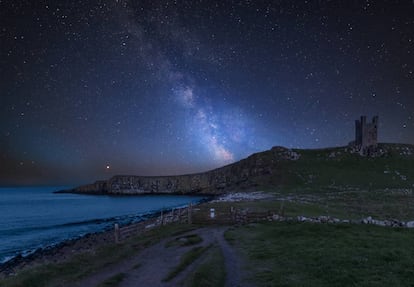‘Right now’ doesn’t exist in the universe
The concept of time is key to understanding perception, but it is not as simple or easy to understand as we would like

This is the story of two nearly identical twins, Iris and Hera. In a way it’s a dystopian story, negative by our current standards: it was their destiny to be separated from a very young age and end up in places very far removed from one another. A few months before turning three, Iris, who missed her sister but did not know where she might be, had her own picture taken. Many copies were made and sent in every direction, in the hopes that this would help locate Iris’s missing twin. Hera did something similar, as they were like two drops of water, even in their thoughts. Considering that neither one knew where the other one lived, the letters containing the photographs traveled for a long time without reaching their intended recipient, a highly improbable event.
One day, when Hera was already 90 years old, she received a letter, opened it and found a picture of herself inside. She looked at it and was reminded of something. She compared it with a picture of herself and recognized her own image at age three. It was a photograph of her long-lost twin sister Iris! But what did she look like these days? Did she grow up to have friends, get married and form a family like herself? Hera liked to think that her twin’s life was similar to her own, full of experiences, some happy, some less so. Perhaps her surroundings were not exactly the same, but the main things surely were not so different, because after all, they were nearly identical sisters!
But there were other, more worrying thoughts in her mind as well. Was Iris still alive? She thought of reaching out and sending her another photograph, but it might take more than the 87 years that had passed since her sister sent her picture. Melancholy, she figured that she, at age 90, could right now only know how her sister Iris was doing at age three. They shared a moment in time that was in reality separated by a whole different existence and life paths.
Hera kept thinking about it. If Iris was doing something right now, if she was still alive, but Hera was not there to see it with her own eyes, did her sister really exist? It was then that Hera understood a bit better the famous phrase “If a tree falls in a forest and no one is around to hear it, does it make a sound?” – a question that was pondered by philosophers such as René Descartes and David Hume. If she could not see or hear her sister right now, it was as though her sister did not exist. But it was so sad to think that way! It was almost better when she was unaware of her sister’s existence, because it was terrifying to realize that reality was not in fact the way she had thought about it until now.
This story about twin sisters could be the story of two galaxies if we multiply it by 155 million every year. The farthest known galaxy at this time is GN-z11, which could be considered our Iris, who sent “photos” of herself in every direction in the form of electromagnetic waves when the universe was around 400 million years old, just three percent of its current age. At that time she had a sister galaxy, perhaps a twin, Hera, which by today’s standards was not that far away. This other galaxy was in fact our own Milky Way, and it had a lifetime ahead of it.
Is “right now” something we might say exists even though we cannot know it?
Now that the universe is nearly 14 billion years old – the 90 years of Hera in our story – we finally know what GN-z11 looks like. Or perhaps we should say what GN-z11 looked like 13.6 billion years ago. But what does “right now” mean to the universe? Is it the union of our earthly present with what we can learn about what happened to GN-z11 a long time ago, together with what we know about other galaxies that are closer and whose light has traveled shorter times allowing us to learn about the universe in younger times? Or is “right now” something we might say exists even though we cannot know it, have no information about it and will not for a long time, perhaps never, because our species will go extinct before that?
More questions: where is, or perhaps more accurately when is (or to create a new cosmological term altogether, wherewhen) GN-z11? Might there be someone in the galaxy that GN-z11 has evolved into that is receiving photons of our own Milky Way? In that case, they would be images of our past, of the way the Milky Way looked like 13.6 billion years ago (neither the Sun nor the Earth existed back then). Could there be someone in another galaxy contemporaneous with GN-z11? If that other galaxy exists and we haven’t yet received its light, it will have followed a timeline of its own that has yet to cross our own. So we will not be able to know about them until a long time from now, perhaps, as is most likely, when humans have disappeared altogether. In that case, do they exist? Just like the solitary tree in the forest, do they “make a sound”?
And as a last turn of the screw: is there right now anyone in a remote and physically (meaning scientifically) inaccessible spot in the universe? If the answer is yes, then reality exists far beyond our own perception and there are aspects of today’s existence that we will never be able to prove, chiefly for lack of time. If the answer is no, they do not exist because we do not perceive them, then we would be breaking the foundations of modern cosmology, the so-called Cosmological Principle, which says that the universe (at a certain scale, but that’s another story) is the same no matter where you are or in which direction you look. This principle, or axiom to use mathematical jargon, can be reformulated to say that physical laws are universal and apply to the entire cosmos.
Or, if we go a step further, the universe at all times and in all places is ruled by the same physics. If so, and there is nothing to prove the contrary so far, although it hasn’t been proven either, like all good axioms; if the universe is more or less the same in all places at a given moment, it would seem that whatever it is that GN-z11 has evolved into, and in any galaxy that shares with us what we might call “a disjointed and unmeasurable right now” (meaning we have no information about it, as that’s impossible), right now there should be the necessary conditions for the emergence of life. And using the same argument, there must also have been the conditions for the existence of intelligent life. If not the case, we would be alone in the universe, which is a very self-centered thought of the kind that time and again throughout history has been proven wrong and even detrimental to our existence.
To conclude, let us consider what we want to be. A Hera who knows about the Iris of the past and is resigned to the fact that she will never get in touch with her? An Iris who doesn’t know and perhaps will never know anything about her sister? Or do we want to be someone who wants to know what happened and where Iris’ letter to Hera traveled and send our own letter back? There will be answers for all tastes.
Tu suscripción se está usando en otro dispositivo
¿Quieres añadir otro usuario a tu suscripción?
Si continúas leyendo en este dispositivo, no se podrá leer en el otro.
FlechaTu suscripción se está usando en otro dispositivo y solo puedes acceder a EL PAÍS desde un dispositivo a la vez.
Si quieres compartir tu cuenta, cambia tu suscripción a la modalidad Premium, así podrás añadir otro usuario. Cada uno accederá con su propia cuenta de email, lo que os permitirá personalizar vuestra experiencia en EL PAÍS.
¿Tienes una suscripción de empresa? Accede aquí para contratar más cuentas.
En el caso de no saber quién está usando tu cuenta, te recomendamos cambiar tu contraseña aquí.
Si decides continuar compartiendo tu cuenta, este mensaje se mostrará en tu dispositivo y en el de la otra persona que está usando tu cuenta de forma indefinida, afectando a tu experiencia de lectura. Puedes consultar aquí los términos y condiciones de la suscripción digital.
More information
Archived In
Últimas noticias
NASA discovers Titan doesn’t have an ocean, but a ‘slushy ice layer’ that increases possibility of life
Innocence lost in the forest of the child soldiers: ‘Each leader of the armed group had his girls’
‘Fallout’ or how the world’s largest company turned an anti-capitalist apocalyptic Western into a phenomenon
From inflation to defending migrants: Eileen Higgins and Zohran Mamdani inaugurate the new Democratic resistance against Trump
Most viewed
- ‘El Limones’ and the growing union disguise of Mexican organized crime
- Christian Louboutin: ‘Young people don’t want to be like their parents. And if their parents wear sneakers, they’re going to look for something else’
- The low-cost creative revolution: How technology is making art accessible to everyone
- ‘We are dying’: Cuba sinks into a health crisis amid medicine shortages and misdiagnosis
- A mountaineer, accused of manslaughter for the death of his partner during a climb: He silenced his phone and refused a helicopter rescue











































